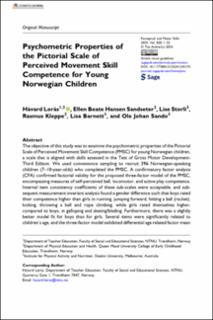Psychometric Properties of the Pictorial Scale of Perceived Movement Skill Competence for Young Norwegian Children
Lorås, Håvard Wuttudal; Sandseter, Ellen Beate Hansen; Storli, Lise; Kleppe, Rasmus; Barnett, Lisa; Sando, Ole Johan
Peer reviewed, Journal article
Published version
Permanent lenke
https://hdl.handle.net/11250/3127718Utgivelsesdato
2024Metadata
Vis full innførselSamlinger
- Artikler (Articles) [173]
- Publikasjoner fra Cristin - DMMH [138]
Originalversjon
Lorås, H., Hansen Sandseter, E. B., Storli, L., Kleppe, R., Barnett, L., & Sando, O. J. (2024). Psychometric Properties of the Pictorial Scale of Perceived Movement Skill Competence for Young Norwegian Children. Perceptual and Motor Skills.First published online April 16, 2024. https://doi.org/10.1177/00315125241245175Sammendrag
The objective of this study was to examine the psychometric properties of the Pictorial Scale of Perceived Movement Skill Competence (PMSC) for young Norwegian children, a scale that is aligned with skills assessed in the Test of Gross Motor Development- Third Edition. We used convenience sampling to recruit 396 Norwegian-speaking children (7–10-year-olds) who completed the PMSC. A confirmatory factor analysis (CFA) confirmed factorial validity for the proposed three-factor model of the PMSC, encompassing measures of self-perceived ball, locomotor, and active play competence. Internal item consistency coefficients of these sub-scales were acceptable, and subsequent measurement invariant analysis found a gender difference such that boys rated their competence higher than girls in running, jumping forward, hitting a ball (racket), kicking, throwing a ball and rope climbing, while girls rated themselves higher, compared to boys, in galloping and skating/blading. Furthermore, there was a slightly better model fit for boys than for girls. Several items were significantly related to children’s age, and the three-factor model exhibited differential age related factor mean differences across older and younger children. Overall, we found the PMSC to have acceptable psychometric properties for confident use in assessing perceived motor competence among 7–10-year-old Norwegian children, though we observed age and gender differences in children’s responses that warrant careful interpretation of results and further research investigation.

